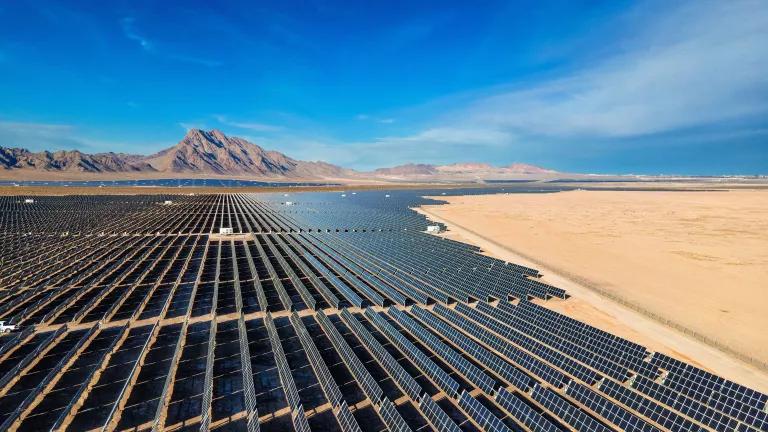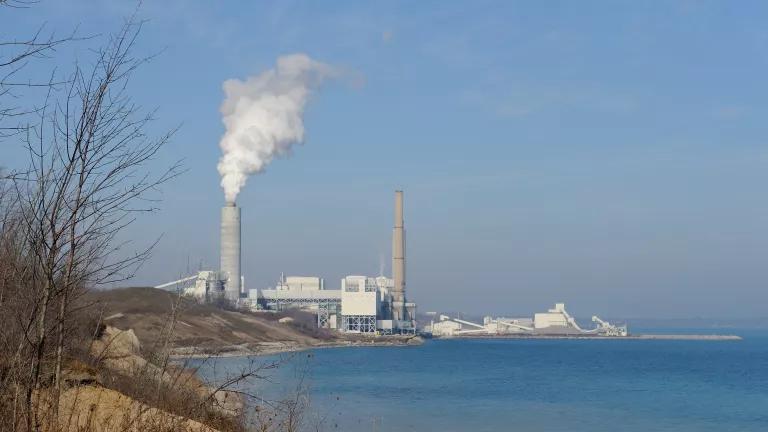Electric Utilities are Essential to the Clean Energy Transition
They will need to double down on clean energy to achieve their climate commitments, and they will need help.

Getty Images
A zero-carbon electric utility sector is a fundamental element of the clean energy transition, but to decarbonize the entire energy system powering our buildings, transportation, and industrial sectors, we also need electric utilities to be active facilitators and partners. We have made great progress in bringing down the costs of clean energy, and increasing penetration of important clean energy technologies, but we need to dramatically accelerate that pace. Luckily, we have the solutions to meet this challenge, reliably and affordably. Electric utilities will play a critical role as the primary investors, long-term system planners, and resource integrators of our electricity system, but they will need to double down, and they will need help.
Great headway…
The electricity sector’s carbon emissions are down 34 percent from the sector’s peak in 2007, thanks in part to the advocacy of NRDC and our partners within states. Other pollutants contributing to public health problems were down significantly as well. Renewables had historic growth in 2023, and estimates for 2024 show wind, solar, and storage making up 94 percent of new capacity additions. Coal’s market share continued to fall to just 17 percent of power generation (down from 45 percent in 2010). In addition, sales of electric vehicles are increasing – more than one million last year – with more than 100 different models being produced. This isn’t just good for the environment and public health; it is also a boost to the economy. A report by Environmental Entrepreneurs estimated that 74,000 clean energy jobs were created just by new clean energy and clean vehicle projects announced in 2023.
Most major electric utilities, servicing over 60 percent of US households, have established net zero carbon goals and many are on the clean energy path – they recognize the clear economic, environmental, and customer demand trends pushing a transition to solar, wind, and energy efficiency to meet customers’ energy needs. A couple of Midwest examples include Consumers Energy in MI (100% emissions reduction by 2040); DTE in IL, MI, and other states (net zero carbon by 2050); Ameren Corporation serving IA, IL, and MO (net zero carbon by 2050); and Commonwealth Edison serving IL (net zero carbon by 2050).
To back up the utility commitments and customer demand, the 2022 Inflation Reduction Act, as well as the Bipartisan Infrastructure Law enacted the year before, have the potential to lead to a decline in the sector by as much as 87 percent by 2035 (from 2005 levels). States are increasingly taking action to curb harmful carbon pollution (17 states have targets of 80-100% before or in 2050 and 24 have established a goal of 100% clean electricity before or in 2050), and the U.S. Environmental Protection Agency's carbon pollution standards is expected to work with the IRA’s incentives and serve as a backstop.
…but dramatically more needed
The U.S. power sector is still the second largest emitting sector in the world’s second largest emitting country, and we are not on the path to meet our collective goals. To meet our goals:
- the electricity grid must triple in capacity by enhancing the existing system and doubling it;
- we need to build roughly 500GW of wind, solar, and storage by 2030;
- And we will need to electrify nearly everything that moves (cars, trucks, buses, and more), including increasing the number of electric vehicle charging ports by nearly 10 times to 30 million.
We must also advance policies that significantly accelerate energy efficiency, demand response, renewable energy, electric vehicles, and that replace direct fossil fuel use in buildings and industry primarily through electrification (from 100% clean energy), in the most affordable and equitable manner possible. This requires supporting policies that modernize and expand the electricity grid in a manner that is sensitive to the impact on people; enables clean energy integration in regional markets, supports distributed energy planning, catalyzes large-scale vehicle charging, and reforms the utility business model.
The nation’s electric utilities are crucial to achieving these goals and as referenced above, many have made ambitious pledges to do so. We need to make sure they follow through.
Opportunities for collaboration and progress
The task ahead is daunting, but the opportunities for progress and common ground are abundant. We share the industry goal of safely providing reliable and clean electricity to customers at an affordable cost. Here are just a handful of areas ripe for collaboration, but there any many more:
- Permitting and siting of renewables and transmission more quickly. The amount of generation waiting to be connected to the grid is now more than double the total installed capacity of the existing U.S. power plant fleet – 95 percent of which is solar, battery storage, and wind energy. Utilities are already making substantial investments in the energy grid and there is still need for further siting and permitting reforms, but today’s grid is also inefficient and underutilized and we should be investing more in grid enhancing technologies (hardware or software that increase the capacity, efficiency, or reliability of the grid at lower cost) since they deploy quickly and can fill the gap while we fix siting issues for new lines. For example, advanced reconductoring is cheaper than new lines, but more expensive than just replacing the old existing line one for one. But this less understood kind of investment raises concerns that it might not be approved because it might be viewed as gold plating by the commission and other stakeholders - even though it could provide up to double the capacity.
- Meeting the increasing demand for electricity being driven by our electrifying, data-dependent economy with the cleanest, most reliable solutions and our carbon reduction commitments. We must meet load growth with efficiency and clean energy, not with increased fossil generation; and ensure large energy buyers’ quickly growing demand for 24/7 clean energy really adds new clean resources and doesn’t negatively impact customers.
- Customer affordability. In addition to keeping costs down by making the most optimal investments, the electricity rates customers pay must be better aligned with our climate and equity goals. Our ability to electrify our homes, businesses, vehicles, and industry depends on it.
- Extreme weather and wildfire mitigation are creating real and growing risks to both the affordability of electricity services due to the rising costs of addressing the impacts, and to clean energy investments critical to meeting our carbon reduction goals (and ironically meant to mitigate these events). In addition to being impacted by the costs from the events themselves, these investments are at risk because the financial community is downgrading utilities because of the risk, which raises the costs of capital, lowering the amount of investment funds available. Liability reform is needed, but so too is a look at how we design our communities and insurance systems to reduce both individual and collective exposure.
Why aren’t utilities moving more quickly on these opportunities?
Over the years, the expectations for utilities to provide safe, reliable, and affordable power has been expanded to include, among other issues, grid resilience, an enhanced urgency to decarbonize, and the need to address increased climate risks (wildfire, drought, extreme weather). These new considerations are vital to addressing the climate crisis at the speed and scale necessary but are no less challenging from a public-policy perspective. However, on the plus side there is also abundant energy efficiency and ever cheaper wind and solar; a proliferation of grid enhancing technologies; flexible distributed energy resources; and other new technologies to increase capacity of existing grid affordably. If we want to see electric utilities become stronger supporters of our transition to a clean energy future, we must change the way they are regulated to align their interests and opportunities with decarbonizing the energy system in the cleanest, most affordable, and equitable manner.
However, utilities typically make more money investing in large new capital projects like power plans and transmission lines than investments in energy efficiency and renewable energy resources. Electric utilities are expected to invest hundreds of billions of dollars over the next decade. We need regulatory reforms that encourage utilities to invest in the good stuff (renewable energy, battery storage, energy efficiency, demand side management, smart transmission & distribution, etc.) relative to what the old business model had driven them to invest in (big fossil power plants and pipelines). Regulation should focus utilities on meeting customers’ service needs and our energy and greenhouse gas reduction goals. Earnings should reward performance, and specifically incent innovation and decarbonization, and utilities should be allowed more decision-making flexibility tied to innovation and results.
Now is not the time for slowing down or moving backward
Despite the bold commitments and abundant alternatives, utilities and investors across the country plan to add 133 new natural gas-fired power plants to our electric grid in the coming years. There are also other signs that some utilities may be considering backtracking on their commitments. For example, Michigan’s DTE agreed in their last long-range energy planning proceeding to retire their largest coal plant, Monroe Power Plant, by 2032, eight years earlier than originally planned. However, the utility left open the possibility of building a large gas plant in a future plan, potentially backtracking on their climate commitments. These plans, if implemented, will blow their carbon budget and could increase costs for customers.
Let’s rise to the challenge
As the Edison Electric Institute President said recently to investors: “This is a very critical moment in our industry…” “What we do in the next several years as an organization and as an industry will ultimately determine our country’s path for decades to come.” He is right about that.
The time to act is now, urgently, and the best way to do it is together.




